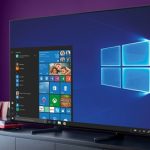Using a TV as a computer monitor has its disadvantages, including reduced screen resolution and potential eye strain. When you connect your computer to a TV, you may experience a lower display resolution compared to a dedicated computer monitor.
This can result in a less sharp and crisp image, making it harder to read text and view details on the screen. Additionally, TVs generally have a higher input lag compared to computer monitors, which can lead to delayed responses and a less smooth user experience.
Moreover, extended use of a TV as a monitor can cause eye fatigue and strain due to the larger screen size and pixel density.

Credit: corp.kaltura.com
Eye Strain
Using a TV as a computer monitor is a popular choice for many people due to its larger screen size and immersive viewing experience. However, it’s important to be aware of the potential disadvantages that come with this setup. One major concern is eye strain, which can occur when staring at a screen for extended periods. In this section, we will explore some of the reasons why using a TV as a computer monitor can lead to eye strain, including backlight issues and text clarity problems.
Backlight Issues
The backlight used in most TVs is designed for optimal viewing conditions from a typical viewing distance. However, when used as a computer monitor, the close proximity can result in excessive brightness or glare. This can put strain on your eyes and cause discomfort. Additionally, the brightness levels and uniformity of the backlight may vary across the screen, leading to differences in how colors and details are perceived. As a result, prolonged use of a TV as a computer monitor can lead to eye fatigue and headaches.
Text Clarity
Another disadvantage of using a TV as a computer monitor is the lower text clarity compared to dedicated computer monitors. TVs are generally optimized for video content, and their display features may prioritize motion handling and color accuracy over text sharpness. This can lead to blurry or pixelated text, especially when working with smaller font sizes or detailed graphics. Struggling to read text on the screen can strain your eyes as you squint or strain to make out the words, making it difficult to work or enjoy a comfortable browsing experience.

Credit: www.checkmarket.com
Limited Functionality
A TV can be an appealing option for those who want to use it as a computer monitor due to its large screen size and affordability. However, it’s important to consider the limitations that come with this choice. One of the major disadvantages is the limited functionality that a TV offers when used as a computer monitor. In this article, we will explore two crucial aspects of limited functionality: input lag and resolution constraints.
Input Lag
TVs are designed primarily for watching movies and TV shows, where a small delay in input response may not be noticeable. However, when it comes to using a TV as a computer monitor, input lag can become a significant concern. Input lag refers to the delay between a user’s input on a keyboard or mouse and the corresponding action displayed on the screen.
Unlike dedicated computer monitors that are optimized for minimal input lag, most TVs suffer from higher input lag due to image processing algorithms and other factors. This delay can be especially problematic for tasks that require precise and real-time input, such as gaming or professional video editing.
To mitigate this issue, some modern TVs offer a “game mode” that reduces input lag by disabling certain image processing features. However, even with this mode enabled, the input lag may remain higher compared to dedicated computer monitors. Therefore, for tasks that demand quick and accurate input, using a TV as a computer monitor may not be the ideal choice.
Resolution Constraints
Another drawback of using a TV as a computer monitor is resolution constraints. While modern TVs boast impressive resolutions, such as 4K or even 8K, they often lack the pixel density necessary for comfortable reading and productive work. TVs are designed to be viewed from a distance, while computer monitors are meant to be viewed up close.
When a TV is used as a computer monitor, the same high resolution that enhances visual experiences with movies and TV shows can lead to readability issues when viewing text and smaller UI elements. The lower pixel density can result in fuzzier text and reduced clarity, leading to eye strain and decreased productivity.
Moreover, TVs typically have a limited range of supported resolutions, which may not align with the optimal resolution settings for certain software applications or games. As a result, users may have to compromise on image quality or experience scaling issues that make content look stretched or distorted.
Using a TV as a computer monitor comes with a set of limitations. The input lag can be higher compared to dedicated computer monitors, affecting tasks that require precise and real-time input. Additionally, the resolution constraints of TVs may result in reduced readability and suboptimal image quality for productive tasks. It’s crucial to evaluate these disadvantages before choosing a TV as a computer monitor to ensure a seamless and efficient computing experience.
Health Concerns
Posture Problems
Using a TV as a computer monitor can cause posture issues due to the need to frequently look up at the screen.
Radiation Exposure
Extended use can increase the risk of radiation exposure from the screen emitting electromagnetic radiation.
Display Longevity
Using a TV as a computer monitor has some disadvantages that can affect its display longevity.
Burn-in Risk
Burn-in is a common issue with TVs used as computer monitors, where static images displayed for extended periods can become permanently imprinted on the screen. This can lead to discoloration and ghosting of images over time.
Shortened Lifespan
TV screens are designed for viewing content at a distance and are optimized for longer viewing hours, whereas computer monitors are built for close-range viewing with task-oriented usage. Utilizing a TV as a computer monitor may lead to a shortened lifespan due to the difference in usage patterns, potentially resulting in diminished display quality and increased likelihood of technical malfunctions.
Adaptability Challenges
When using a TV as a computer monitor, several adaptability challenges come into play. These challenges can affect the overall usability and performance of the setup, making it important to consider the potential drawbacks. Below, we’ll explore the specific adaptability challenges in more detail.
Interface Compatibility
TVs and computer monitors use different interfaces, with computers typically using HDMI, DisplayPort, or VGA, while TVs may also have additional connections such as RCA or component inputs. This can lead to compatibility issues, as not all TV interfaces may work well with computer devices. Additionally, the refresh rates and response times of TV displays may not be optimized for computer use, resulting in subpar performance and image quality.
Screen Size Limitations
Due to their larger size, TVs may present screen size limitations when used as computer monitors. Many TVs are designed for viewing from a distance, leading to potential strain on the eyes when used as close-proximity computer displays. Additionally, the larger size may not be conducive to multitasking, as it can be more challenging to navigate between windows and applications on a single, oversized screen.

Credit: www.pcmag.com
Frequently Asked Questions On Disadvantages Of Using A Tv As A Computer Monitor
What Are The Downsides Of A Tv As A Monitor?
One downside of using a TV as a monitor is scaling issues due to different resolutions. Text may appear blurry or pixelated. Color accuracy and input lag can also be concerns.
Why Not To Use Tv As Monitor?
Using a TV as a monitor isn’t recommended due to the differences in screen resolution, refresh rates, and pixel density. TVs are designed for watching from a distance, while monitors provide a sharper and more detailed image up close. This can lead to eye strain and reduced overall picture quality.
Is A Tv Better Than A Monitor For Pc?
Yes, a TV is better for PC due to its larger screen size and higher resolution, providing a more immersive visual experience. It can also be used for various entertainment purposes.
Is Using A Tv As A Monitor Bad For Eyes?
Using a TV as a monitor can strain eyes due to proximity and screen glare. Positioning and breaks can help alleviate discomfort.
Conclusion
Using a TV as a computer monitor may lead to eye strain and reduced productivity. Cable clutter and image quality issues can also arise. Remember to consider these drawbacks before making your decision. Opting for a dedicated monitor might be a better choice for your overall experience and comfort.









